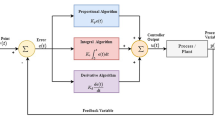Abstract
The grey wolf optimization algorithm is proposed to design proportional, integrative and derivative controllers using a two degrees of freedom control configuration. The control system is designed in order to achieve good set-point tracking and disturbance rejection performance. The design is accomplished by minimizing an aggregated cost function based on the time-weighted absolute error integral, subjected to robustness constraints. The control system robustness levels are prescribed in terms of the vector margin and maximum complementary sensitivity function values. Simulation results are presented for several common systems dynamics and compared with the ones obtained with a particle swarm optimization algorithm.












Similar content being viewed by others
References
Aström KJ (2002) Control system design. Chapter 7:255
Åström KJ, Hägglund T, Hang CC, Ho WK (1993) Automatic tuning and adaptation for PID controllers-a survey. Control Eng Pract 1:699–714
Åström KJ, Hägglund T (2004) Revisiting the Ziegler–Nichols step response method for PID control. J Process Control 14:635–650
Cohen GH, Coon GA (1953) Theoretical considerations of retarded control. Trans ASME 75:827–834
De Moura Oliveira PB, Cunha JB, Coelho JP (2002) Design of PID controllers using the particle swarm algorithm. In: proceedings of IASTED MIC’2002, February, Innsbruck, Austria, p 263–26
Ender DB (1993) Process control performance: not as good as you think. Control Eng 40:180–190
Franklin GF, Powell JD, Naeiini AE (1991) Feedback Control of Dynamic Systems. Addison-Wesley, Boston
Freire HF, Moura Oliveira PB, Solteiro Pires EJ, Bessa M (2014) Many-Objective PSO PID Controller Tuning. In: CONTROLO’2014—proceedings of the 11th Portuguese conference on automatic control (Lecture notes in electrical engineering), vol 321, Springer, p 183–192
Freire HF, Moura Oliveira PB, Solteiro Pires EJ (2016) From single to many-objective PID controller design using particle swarm optimization. Int J Control Autom Syst. doi:10.1007/s12555-015-0271-0
Guha D, Roy PK, Banerjee S (2016) Load frequency control of interconnected power system using grey wolf optimization. Swarm Evol Comput 27:97–115
Hägglund T (2012) Signal Filtering in PID Control. In: IFAC Conference on Advances in PID Control PID’12, Brescia (Italy), March, WePl.1
Hast M, Aström KJ, Bernhardsson B, Boyd S (2013) PID Design by Convex-Concave Optimization. In: 2013 European control conference (EEC), Switzerland, p 4460–4465
Jahanshahi E, Sivalingam S, Schofield JB (2015) Industrial test setup for autotuning of PID controllers in large-scale processes: applied to Tennessee Eastman process. In: preprints of the 9th international symposium on advance control of chemical processes, p 469–476
Jones AH, Moura Oliveira PB (1995) Genetic auto-tuning of PID controllers, GALESIA. In: Fifth IEE conference on genetic algorithms in engineering systems: innovations and applications, vol 414, p 141–145
Kaushik D, Diptanu D, Joyashree D (2015) Optimal tuning of PID controller using GWO algorithm for speed control in DC motor. In: 2015 international conference on soft computing techniques and implementations- (ICSCTI), pp 108–112. doi:10.1109/ICSCTI.2015.7489575
Kennedy J, Eberhart RC (1995) Particle swarm optimization. In: Proceedings of the IEEE International conference on neural networks IV, Piscataway, p 1942–1948
McMillan G (2014) So many tuning Rules, so little time, control. http://www.controlglobal.com/assets/14WPpdf/141016-McMillanTunningRules.pdf. Retrieved in 2 May 2016
Moharam A, El-Hosseini MA, Ali HA (2016) Design of optimal PID controller using hybrid differential evolution and particle swarm optimization with an aging leader and challengers. Applied Soft Computing 38:727–737
Moura Oliveira PB, Solteiro Pires EJ, Novais P (2015) Design of Posicast PID control systems using a gravitational search algorithm. Neurocomputing, Elsevier, Available online 9 May. doi:10.1016/j.neucom.2014.12.101
Moura Oliveira PB, Vrančić D (September 2016) Grey Wolf, gravitational search and particle swarm optimizers: a comparison for PID controller design. In: Proceedings of the Controlo’2016: 12th Portuguese conference on automatic control
Murrill PW (1967) Automatic control of processes. Scranton International Textbook Co., Scranton
O’Dwyer A (2006) Handbook of PI and PID controller tuning rules, 2nd edn. Imperial College Press, London
Reyes-Sierra M, Coello CAC (2006) Multi-objective particle swarm optimizers: a survey of the state-of-the-art. Int J Comput Intell Res 2(3):287–308. ISSN 0973-1873
Segovia VR, Aström KJ, Hägglund T (2013) Noise filtering in PI and PID Control. In: 2013 American control conference (ACC), Washington, DC, USA
Seyedali M, Mohammad SM, Lewis A (2014) Grey wolf optimizer. Adv Eng Softw 69:46–61
Sharma Y, Saikia LC (2015) Automatic generation control of a multi-area ST—thermal power system using grey wolf optimizer algorithm based classical controllers. Int J Electr Power Energy Syst 73:853–862
Shekhar Y, Verma SK, Nagar SK (2016) Optimized PID controller for magnetic levitation system. IFAC-PapersOnLine 49–1:778–782
Skogestad S (2003) Simple analytic rules for model reduction and PID controller tuning. J Process Control 13:291–309
Vrančić D, Strmčnik S, Juričić D (2001) A magnitude optimum multiple integration method for filtered PID controller. Automatica 37:1473–1479
Zhang Y, Wang S, Ji G (2015) A comprehensive survey on particle swarm optimization algorithm and its applications. Hindawi Publishing Corporation. doi:10.1155/2015/931256
Zhao S-Z, Iruthayarajan MW, Baskar S, Suganthan PN (2011) Multi-objective robust PID controller tuning using two lbests multi-objective particle swarm optimization. Inf Sci 181(16):3323–3335 (Elsevier)
Ziegler JG, Nichols NB (1942) Optimum settings for automatic controllers. Trans ASME 64:759–768
Author information
Authors and Affiliations
Corresponding author
Ethics declarations
Conflict of interest
The authors declare that they have no conflict of interest.
Ethical approval
This article does not contain any studies with human participants or animals performed by any of the authors.
Additional information
Communicated by A. Herrero.
Rights and permissions
About this article
Cite this article
de Moura Oliveira, P.B., Freire, H. & Solteiro Pires, E.J. Grey wolf optimization for PID controller design with prescribed robustness margins. Soft Comput 20, 4243–4255 (2016). https://doi.org/10.1007/s00500-016-2291-y
Published:
Issue Date:
DOI: https://doi.org/10.1007/s00500-016-2291-y




